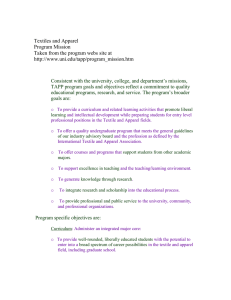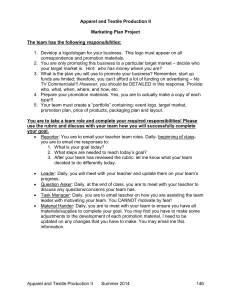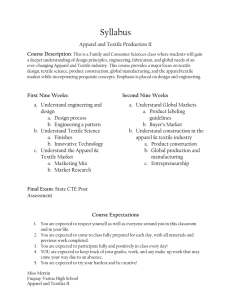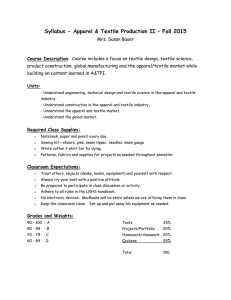Elements of design • Color • Line • Shape/Silhouette
advertisement
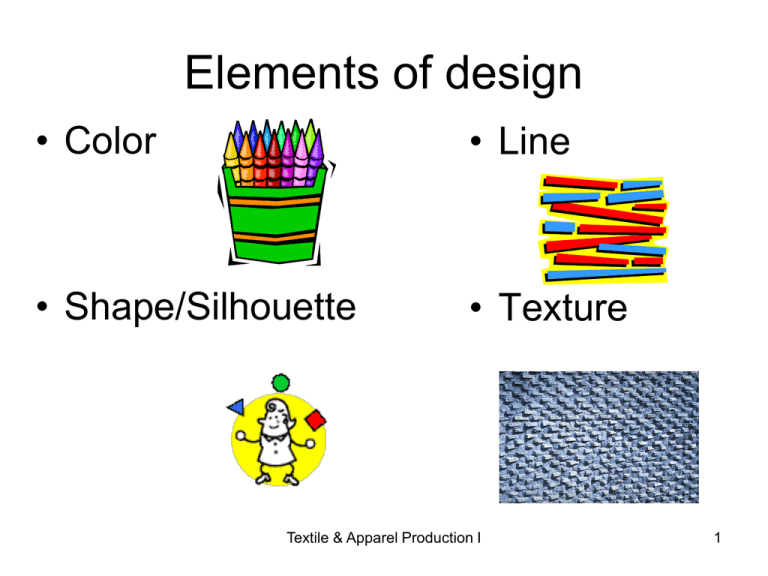
Elements of design • Color • Line • Shape/Silhouette • Texture Textile & Apparel Production I 1 Color Hue: (1) The technical word for color. (2) The name given to a color, such as red or yellow, that distinguishes one color from another. Value: The lightness or darkness of a color. Tint: The lighter hue created when white is added to a color. Shade: The darker hue created when black is added to a color. Intensity: The brightness or dullness of a color. Neutrals: Black, white, beige, and gray. Neutrals can be used alone or with any other colors. Textile & Apparel Production I 2 • Primary hues: Red, yellow, blue. These colors cannot be made by using any other color. All other colors are made from a combination of these. • Secondary hues: Orange, green, violet. These are created by mixing equal amounts of two primary colors. Textile & Apparel Production I 3 Color schemes Plans that can be used to provide harmonious color combinations. • Monochromatic • Splitcomplementary • Analogous • Triad • Complementary • Accented Neutrals Textile & Apparel Production I 4 Monochromatic color Analogous colors • Different tints, shades, and intensities of a single color. Two to five colors that are adjacent on the color wheel. • Example: light blue trousers and jacket with a navy blue vest. Example: orange, yelloworange and yellow worn together Textile & Apparel Production I 5 Complementary colors Two colors opposite each other on the color wheel. Example: Orange and blue Split-complementary colors One color plus the colors on each side of its complement. Example: red combines with yellow-green and blue-green. Textile & Apparel Production I 6 Triad colors Three colors that are equidistant from each other on the color wheel. Accented neutral White, gray, black, or beige with a bright color accent. Example: Businesswoman wearing a gray dress with a red scarf. Textile & Apparel Production I 7 Shape The silhouette or the overall form or outline of an outfit or clothing style. Most silhouettes are formed by: The width and length of the neckline, sleeves, and/or waistline. The width and length of pants and skirts. Textile & Apparel Production I 8 Form • 3 dimensional space • Height, width, and depth • Classified as geometric or organic (free form) Textile & Apparel Production I 9 Line A distinct, elongated mark that can lead the path of eye movement up and down, side to side, or around objects. • Give direction, or a feeling of movement • Provides visual direction • Helps draw attention to good points and play down the bad ones. Basic types of lines Straight lines: Lines without curves or bends. Straight lines are severe and formal and suggest power and dignity. Curved lines: Circular or gently waved lines. Curved lines add softness and roundness to apparel. Textile & Apparel Production I 10 Directions of lines •Vertical lines: Lines that go up and down. Vertical lines create a taller, more slender look. •Horizontal lines: Lines that go across. Horizontal lines give a shorter, wider look. •Diagonal lines: Lines that slant at an angle rather than being vertical or horizontal. Textile & Apparel Production I 11 Ways to create lines in garments •Structural lines: Lines formed by the seams, darts, pleats, tucks, and edges when garments are constructed. •Decorative lines: Lines created by details added to the surface of clothing including fabric design and trims such as top-stitching, lace, tabs, flaps, and buttons used to decorate the garment. Textile & Apparel Production I 12 Texture: The look and feel of fabric. •Can create illusions of size •Can disguise figure irregularities •Can add interest to a garment Texture can be provided in two ways… Structural texture: Texture determined by the fibers, yarns, and the method of construction used to produce a garment. Examples: velvet shirt, striped wool pants Added visual texture: The finishes and designs applied to the surface of the fabric. Examples: The print of the fabric can give the illusion of height or width to the wearer. Shiny textures make people look larger because they reflect light. Textile & Apparel Production I 13 Collect images of the following and email them as one document to cassondra_macleod@iss.k12.nc.us • A photo in nature that inspires you • A historical garment prior to the 21st century that inspires you • A celebrity photo, or some form of media that inspires you • A news article of a current event that could influence fashion/ style (can be a separate link in email) Principles of design • • • • Balance Proportion Emphasis Rhythm Textile & Apparel Production I 15 The principle of design that implies equilibrium or Balance steadiness among the parts of a design or outfit. •Balance in garments is produced by structural parts and added decoration. •A properly balanced garment appears equal in weight and power of attraction from all sides, from top to bottom, and from front to back. Formal balance Equilibrium provided by symmetrical parts. One side resembles the other. Informal balance Textile & Apparel Production I Equilibrium provided by asymmetrical parts. One side is unequal to the other. 16 Proportion The principle of design dealing with the relative sizes of all the parts in a design to each other and to the whole. •Garment details and accessories should be proportioned for the wearer. •Proportion is most pleasing when garment areas are unevenly divided. Textile & Apparel Production I 17 Emphasis The principle of design that uses a concentration of interest or area of focus in a particular part or area of design. • Emphasis or a focal point can be used to draw attention or to keep the eye away. • Emphasis can be provided through the use of color, texture, structural lines, decorative lines, or accessories. Textile & Apparel Production I 18 The principle of design concerned with the pleasing arrangement of the design Rhythm elements to produce a feeling of continuity or easy movement of the observer’s eye. Gradation Or Radiation: Alternation: Repetition: Progression: Rhythm Rhythm Rhythm Rhythm created by created by created by created by a lines alternating repeated gradual emerging from elements such lines, increase or a central point as light and shapes, decrease of like rays, dark colors or colors, or similar design resulting in stripes of two textures in elements. the parts colors or sizes. a garment. being an equal distance from a given point. Textile & Apparel Production I 19 To appear shorter and thicker • • • • • • • • Sharply contrasting colors Light, bright, warm colors Wide silhouettes Horizontal lines Bold prints, plaids Bulky texture Wide, contrasting belt Gathers or pleats To appear taller and thinner Black, navy blue, charcoal, and chocolate brown Monochromatic colors Straight silhouettes Vertical lines Subtle prints, plaids Smooth, flat textures Narrow, matching belt Textile & Apparel Production I 20
